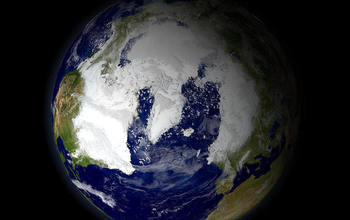All Images
News Release 14-081
Ancient ocean currents may have changed pace and intensity of ice ages
Slowing of currents may have flipped switch
This material is available primarily for archival purposes. Telephone numbers or other contact information may be out of date; please see current contact information at media contacts.

About 950,000 years ago, North Atlantic currents, Northern Hemisphere ice sheets underwent changes.
Credit: NASA
Download the high-resolution JPG version of the image. (110.2 KB)
Use your mouse to right-click (Mac users may need to Ctrl-click) the link above and choose the option that will save the file or target to your computer.

Ocean currents slowed 950,000 years ago, triggering colder but less frequent ice ages.
Credit: Leo Pena
Download the high-resolution JPEG version of the image. (70.7 KB)
Use your mouse to right-click (Mac users may need to Ctrl-click) the link above and choose the option that will save the file or target to your computer.

Scientists (pictured: Leo Pena) analyzed fossil plankton shells to reconstruct ocean circulation.
Credit: Kim Martineau
Download the high-resolution JPEG version of the image. (90.9 KB)
Use your mouse to right-click (Mac users may need to Ctrl-click) the link above and choose the option that will save the file or target to your computer.

In an Ultra Clean Lab, neodymium isotopes in fossils were isolated and measured.
Credit: Leo Pena
Download the high-resolution JPEG version of the image. (94.7 KB)
Use your mouse to right-click (Mac users may need to Ctrl-click) the link above and choose the option that will save the file or target to your computer.

The scientific drillship JOIDES Resolution was used as a platform to collect deep-ocean sediment.
Credit: IODP
Download the high-resolution JPG version of the image. (777.5 KB)
Use your mouse to right-click (Mac users may need to Ctrl-click) the link above and choose the option that will save the file or target to your computer.

Natural gas extracted from a deep shale formation by hydraulic fracturing (fracking) technology burns at a well in Bradford County, Pennsylvania. Fracking is enabling a shale gas production boom, remaking energy markets and stoking environmental concerns. See page 1464.
Credit: Photo Copyright Les Stone - Corbis
Download the high-resolution JPG version of the image. (145.0 KB)
Use your mouse to right-click (Mac users may need to Ctrl-click) the link above and choose the option that will save the file or target to your computer.


